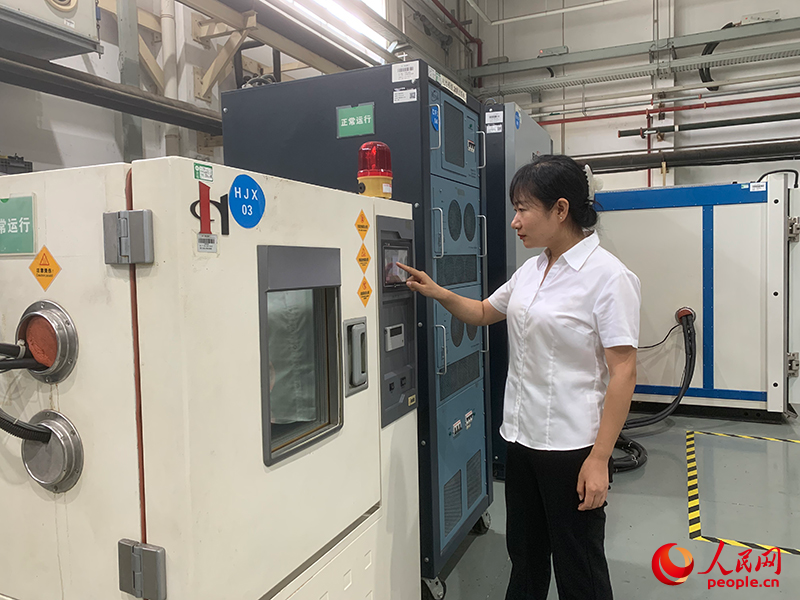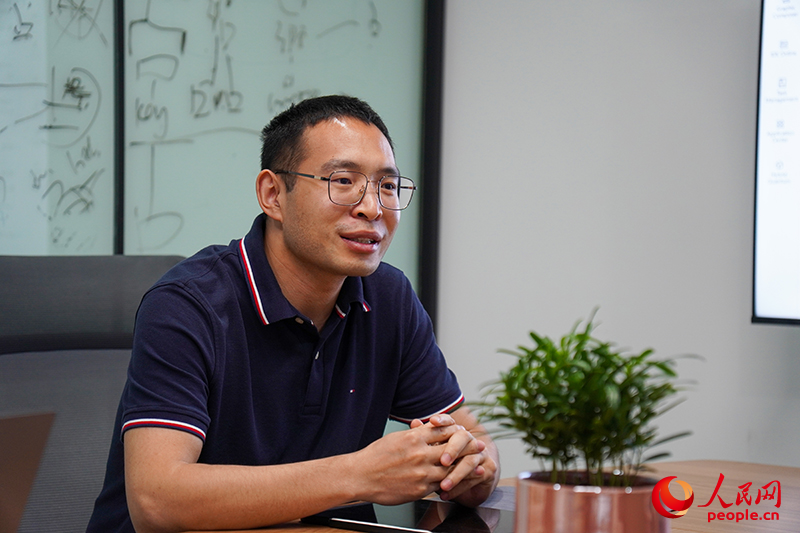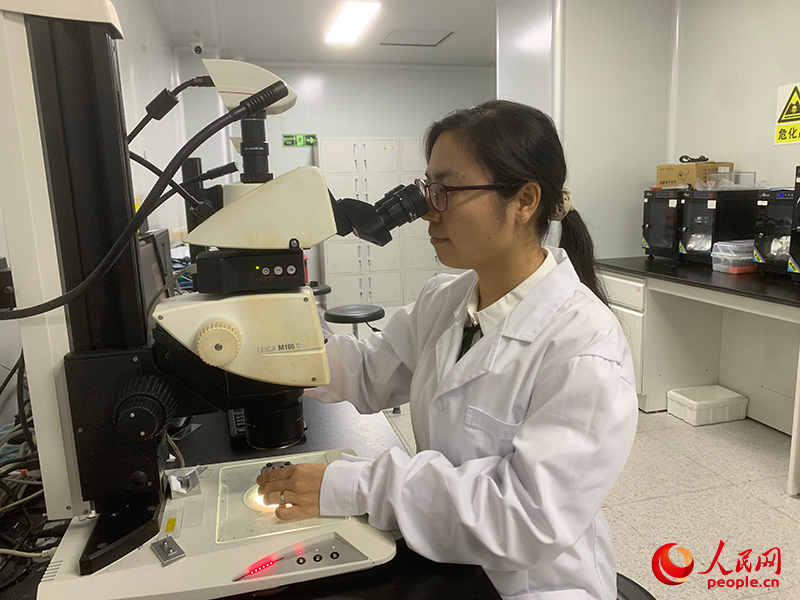24 hours in Hefei, China’s emerging innovation and tech hub
Which city has been the fastest developing city in China in recent years? Many people give the answer: " Hefei!”
Two years ago, Hefei's aggregate economic ranking was outside the top 80 cities in China, but today it is ranked in the top 20.
Hefei's economic turnaround is inseparable from scientific and technological innovation. In a 2023 report produced by publication Nature, a well-known scientific magazine, Hefei was placed at 13th in a ranking of the world's scientific research cities.
In innovation driven Hefei, what does a day look like?
Time: 8 a. m.
Battery expert Xu Aiqin: "Powering up the leading industry"
It is the daily work of battery expert Xu Aiqin to find a balance between battery life, charging, weight and cost performance.

Battery expert Xu Aiqin is testing battery safety(People's Daily Online/Chen Hao)
The automotive industry is the premier industry of Hefei city, Anhui Province. In recent years, Anhui automotive industry pioneering company Jianghuai Automobile Co., Ltd. (JAC) has adeptly navigated the changing landscape, focusing on the new energy vehicle (NEV) sector. In 2011, upon graduating from Hefei University of Technology with a master’s degree in Vehicular Engineering, Xu committed herself to the growing field of NEVs. She has since been a part of the development of 10 new pure electric vehicles for JAC.
At 8 a.m., Xu arrives at the battery safety test cabinet. Today's task is to observe the safety performance of the new batteries at extreme conditions, including testing the batteries at temperatures up to 130℃.
“In the battery field, thermal runaway safety, - that is, ensuring the safety of the entire battery pack when a single cell fails – is of the utmost importance,” Xu explained. After investing a great deal of time and effort, JAC has introduced a revolutionary new battery design. The new design, which is in the shape of a honeycomb, achieves thermal isolation, electric isolation, and thermal decoupling creating a much safer battery. “Each battery undergoes 100 consecutive explosion tests, in which there is zero tolerance for any thermal spread following a single cell combustion,” added Xu, emphasizing the strict safety standards in place.
Small sized yet powerful battery packs are driving NEVs forward and are helping to promote the development of Hefei’s premier industry. In 2023, Hefei produced 1.34 million vehicles,
Time: 2 p.m.
Entrepreneur Han Dongcheng: "The core technology that cannot be bought"
"Today, I’m not holding the usual script,” said University of Science and Technology of China President Bao Xinhe on June 22 at the school’s graduation ceremony. Being able to deliver the speech without notes was not because of a sudden boost in memory, but thanks to the assistance of Han Dongcheng, a PhD graduate majoring in optics at the university, Bao added.

The picture is Han Dongcheng, who is conducting the experiment. (Photo by Xu Ganjiang)
The "help" Bao refers to is the "Interactive aerial imaging technology" independently developed by Han.
This technology allows an image of Bao’s script to appear in the air in front of him, without it being visible to anyone else. What’s more, people can operate and work on the displayed images in the same manner one would use a computer screen.
After finishing with visitors in the morning, it was already 2 p.m. These days, many people visit Anhui Easpeed Co., Ltd., which was founded by Han in 2016. At that time, he was still a first-year master’s degree student at the University of Science and Technology of China.
"The key to the realization of air imaging is in the glass,” says Han. In Anhui Easpeed Co., Ltd., there is a room stacked with substandard glass. "Each piece represents a failure and the beginning of a new attempt,” added Han.
With the successful development of the negative refractive slab lenses, or DCT-plates, and the sensors required for interaction, Anhui Easpeed Co., Ltd. has mastered the interactive aerial imaging technology.
"Core technology can't be bought,” exclaimed Han. Looking back on the journey, Han reflected emotionally regarding how the technology was once controlled by others. Today though, the company has repositioned itself from follower, to competitor, to leader in the industry. As a now industry leader, the company has been able to apply its technology in fields such as displays, medical equipment, automobiles, home appliances, and more. The company is currently valued at 3 billion yuan ($ 412 million).
In Hefei, technological entrepreneurship is thriving. The city has cultivated 188 national-level specialized and innovative "little giant" enterprises, over 8000 national high-tech enterprises and 11,000 national science and technology based small-medium sized enterprises.
Time: 8 p.m.
Key technical expert Sun Hantao: "The industries of the future are already here"
At 8 p.m., Sun finished his day's work.
Recently, as the key technical expert of China Telecom Quantum Group, Sun is particularly busy. "We are currently working with several enterprises, using the recently announced 504-bit ‘Xiaohong’ chip, to develop a full-scale quantum computer. The system will be integrated into the independently developed ‘Tianyan’ quantum computing cloud platform, which will be made available to users across the globe,” said Sun.

Sun Hantao discusses technical issues with his colleagues (People's Daily Online/Chen Ruotian)
Sun, born in the 90s, is from Henan Province, central China. Ten years ago, after graduating from Jilin University, he directly entered into a PhD program at Peking University, studying quantum transport. In 2019, he entered the industry and joined a major internet company in Hangzhou. At the beginning of this year, he relocated to Hefei and became the leader of the quantum computing technology department of China Telecom Quantum Group, where he is responsible for the group's cloud platform construction, physical machine control and other work.
The achievements of Sun and his colleagues are obvious to all.
Taking the cloud platform as an example, the "Tianyan" quantum computing cloud platform has currently integrated the same 176-bit superconducting quantum computer as the Zuchongzhi No. 2, achieving leadership in both real machine and simulation capabilities. Sun reveals that the group has also developed a quantum programming framework based on domestically produced instruction sets, as well as an ecosystem for quantum computing education and industrial applications, effectively securing control over both hardware and software.
"The number of quantum enterprises in Hefei ranks first in China, including a premier enterprise in the industry like China Telecom Quantum Group," said Sun. Sun will continue to work hard to contribute to the development of the industry.
With the efforts of people like Sun, Hefei quantum information, fusion energy, deep space exploration and other future industries will be developed.
Time: 2 a. m.
Researcher Liu Xiaodi: "Devoted to the ‘Cold Bench’ of basic research“
At 2 a. m., Liu sat in front of the testing instrument and carefully observed the changes of hydrogen under different pressures. "It takes at least 10 hours to charge the hydrogen into the press and to record the data,” said Liu. For her, doing experiments all night is common.

Liu Xiaodi is doing research, and for her, doing experiments all night is common(People's Daily Online/Chen Hao)
Liu is a researcher at the Institute of Solid State Physics, Hefei Institutes of Physical Science, Chinese Academy of Sciences. In 2013, after graduating from the University of Science and Technology of China, she sat on the ‘cold bench’, a term for unheralded tasks, for basic research and dedicated herself to the production of metallic hydrogen. "Almost all of my work revolves around this main thread,” said Liu.
The production of metallic hydrogen is known as the 'Holy Grail of High Pressure Physics', which explains just how difficult the task is.
"Creating ultra-high pressure is one of the most difficult problems," according to Liu. There is speculation that to get metallic hydrogen, pressures of 5 or 6 million atmospheres are required. For context, 10,000 atmospheres are roughly the equivalent pressure created by an elephant stepping on something while wearing high heels.
In the experiment, she operates a press using diamond anvil cells (DAC) to apply pressure to the hydrogen. "At present, our pressure is close to the pressure needed to produce metallic hydrogen,” said Liu.
"It gives us great confidence," Liu remarks, indicating that through the optimization of the press, diamond anvil cells, and the process involved, it will soon be possible to achieve ultra-high pressure. With ultra-high pressure achieved, it will be possible to successfully produce metallic hydrogen, allowing for the exploration of its novel properties including superconductivity and superfluidity.
When Liu Xiaodi walked out of the laboratory, there was already daylight.
This is an ordinary 24 hours in innovative Hefei.
A new day, and it all begins again.
(Pan Yidan, as an intern, also contributed to this article.)
Photos
Related Stories
- Singaporean company thrives in Suchu High-Tech Industrial Park
- Wuhu rises as a new automotive city along the Yangtze River
- China's Wuhu appoints officer to offer personalized help for overseas firms
- Sunset view of Hongcun Village in Yixian County, E China's Anhui
- Trending in China | Candy bean Chinese characters from Anhui
- View of ancient architecture complex in E China's Xucun Village
- Tourists visit Hongcun Village in county of Anhui, E China
- China's Anhui emerges as popular destination for foreign investors
- Tiandu peak attracts tourists in Huangshan Mountain scenic area, E China
- Primate research team of Anhui University protects unique species in Huangshan
Copyright © 2024 People's Daily Online. All Rights Reserved.









